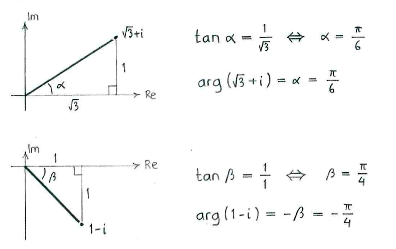Lösung 3.2:5c
Aus Online Mathematik Brückenkurs 2
(Unterschied zwischen Versionen)
K (Solution 3.2:5c moved to Lösung 3.2:5c: Robot: moved page) |
|||
| Zeile 1: | Zeile 1: | ||
| - | + | Geometrisch ist das Argument von einen Produkt, die Summe der Argumente der beiden Terme. Also ist das Argument von <math>(\sqrt{3}+i)(1-i)</math> die Summe der Argumenten von <math>\sqrt{3}+i</math> und <math>1-i</math>, | |
{{Abgesetzte Formel||<math>\arg \bigl((\sqrt{3}+i)(1-i)\bigr) = \arg (\sqrt{3}+i) + \arg (1-i)\,\textrm{.}</math>}} | {{Abgesetzte Formel||<math>\arg \bigl((\sqrt{3}+i)(1-i)\bigr) = \arg (\sqrt{3}+i) + \arg (1-i)\,\textrm{.}</math>}} | ||
| - | + | Indem wir die Faktoren in der komplexen Zahlenebene einzeichnen, könne wir deren Argumente durch Trigonometrie berechnen. | |
| - | + | ||
[[Image:3_2_5_c.gif|center]] | [[Image:3_2_5_c.gif|center]] | ||
| - | ( | + | (Nachdem <math>1-i</math> im vierten Quadrant liegt, is das Argument |
| - | <math>-\beta</math> | + | <math>-\beta</math> und nicht <math>\beta</math>.) |
| - | + | Daher erhalten wir, | |
{{Abgesetzte Formel||<math>\arg \bigl((\sqrt{3}+i)(1-i)\bigr) = \arg (\sqrt{3}+i) + \arg (1-i) = \frac{\pi}{6} - \frac{\pi}{4} = -\frac{\pi}{12}\,\textrm{.}</math>}} | {{Abgesetzte Formel||<math>\arg \bigl((\sqrt{3}+i)(1-i)\bigr) = \arg (\sqrt{3}+i) + \arg (1-i) = \frac{\pi}{6} - \frac{\pi}{4} = -\frac{\pi}{12}\,\textrm{.}</math>}} | ||
| - | + | Hinweis: Wenn wir das Argument wie ein Winkel zwischen <math>0</math> und <math>2\pi </math> schreiben, ist die Antwort | |
{{Abgesetzte Formel||<math>-\frac{\pi}{12}+2\pi = \frac{-\pi+24\pi}{12} = \frac{23\pi}{12}\,\textrm{.}</math>}} | {{Abgesetzte Formel||<math>-\frac{\pi}{12}+2\pi = \frac{-\pi+24\pi}{12} = \frac{23\pi}{12}\,\textrm{.}</math>}} | ||
Version vom 12:53, 13. Mai 2009
Geometrisch ist das Argument von einen Produkt, die Summe der Argumente der beiden Terme. Also ist das Argument von \displaystyle (\sqrt{3}+i)(1-i) die Summe der Argumenten von \displaystyle \sqrt{3}+i und \displaystyle 1-i,
| \displaystyle \arg \bigl((\sqrt{3}+i)(1-i)\bigr) = \arg (\sqrt{3}+i) + \arg (1-i)\,\textrm{.} |
Indem wir die Faktoren in der komplexen Zahlenebene einzeichnen, könne wir deren Argumente durch Trigonometrie berechnen.
(Nachdem \displaystyle 1-i im vierten Quadrant liegt, is das Argument \displaystyle -\beta und nicht \displaystyle \beta.)
Daher erhalten wir,
| \displaystyle \arg \bigl((\sqrt{3}+i)(1-i)\bigr) = \arg (\sqrt{3}+i) + \arg (1-i) = \frac{\pi}{6} - \frac{\pi}{4} = -\frac{\pi}{12}\,\textrm{.} |
Hinweis: Wenn wir das Argument wie ein Winkel zwischen \displaystyle 0 und \displaystyle 2\pi schreiben, ist die Antwort
| \displaystyle -\frac{\pi}{12}+2\pi = \frac{-\pi+24\pi}{12} = \frac{23\pi}{12}\,\textrm{.} |

